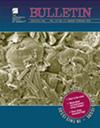白垩纪造山过程引发了东亚干旱化和水系演化
IF 3.9
1区 地球科学
Q1 GEOSCIENCES, MULTIDISCIPLINARY
引用次数: 1
摘要
了解晚中生代青藏高原的地形和水系是了解青藏高原新生代构造动力学的基础。然而,对青藏高原前新生代地表隆升历史和沉积路径系统的系统分析仍然很少。本文介绍了青藏高原东南部关键枢纽兰坪盆地的古流和U-Pb碎屑锆石年代学的新成果,并整合多学科数据集,以约束沉积物物源,重建整个白垩纪的古地形及其流域系统。研究结果表明,青藏高原东南部早白垩世至晚白垩世(约Albian - Santonian)发生了构造引起的地表隆起,形成了广泛的地形屏障,并形成了东亚内陆的雨影。这种地形模式与亚洲东部边缘的高地叠加在一起,意味着白垩纪东亚的地形特征是一个封闭的古地貌模式,东西都高,从东西向南排水,与之前提出的构造形成对比。这种地形格局中断了大气环流格局,造成了东亚广泛的大陆内沙漠化和水系网演变。我们的研究限定了新生代印度与欧亚大陆碰撞前青藏高原晚中生代发育的关键部分,并将提高我们对东亚大陆古气候、大气环流和现代排水系统演化的认识。本文章由计算机程序翻译,如有差异,请以英文原文为准。
Cretaceous mountain building processes triggered the aridification and drainage evolution in east Asia
Knowledge of the late Mesozoic topography and drainage system of the Tibetan Plateau is essential for understanding the Cenozoic tectonic dynamics of the plateau. However, systematic analyses of the pre-Cenozoic surface uplift history and sediment-routing systems of the Tibetan Plateau remain sparse. Here we present new results for paleocurrents and U-Pb detrital zircon geochronology from the Lanping Basin, a key junction in the southeastern (SE) Tibetan Plateau, and integrate multidisciplinary data sets to constrain sediment provenance and reconstruct paleotopography and its drainage system throughout the Cretaceous. Our results indicate that mid- to Late Cretaceous (ca. Albian−Santonian) tectonically induced surface uplift occurred in the SE Tibetan Plateau, leading to the build-up of an extensive topographic barrier, and resultant rain shadows in the interior of east Asia. Superimposition of this topographic pattern by uplands in the eastern margin of Asia meant that the Cretaceous topography of east Asia was characterized by an enclosed paleo-relief pattern that was high in both the east and west, with drainage from the east and west to the south, contrasting with previously proposed configurations. This topographic pattern interrupted the atmospheric circulation pattern and generated widespread intracontinental desertification and drainage network evolution in east Asia. Our study constrains a key part of the late Mesozoic growth of the Tibetan Plateau prior to the Cenozoic collision between India and Eurasia and will improve our understanding of the paleoclimate, atmospheric circulation, and modern drainage system evolution of the east Asian continent.
求助全文
通过发布文献求助,成功后即可免费获取论文全文。
去求助
来源期刊

Geological Society of America Bulletin
地学-地球科学综合
CiteScore
9.30
自引率
8.20%
发文量
159
审稿时长
4-8 weeks
期刊介绍:
The GSA Bulletin is the Society''s premier scholarly journal, published continuously since 1890. Its first editor was William John (WJ) McGee, who was responsible for establishing much of its original style and format. Fully refereed, each bimonthly issue includes 16-20 papers focusing on the most definitive, timely, and classic-style research in all earth-science disciplines. The Bulletin welcomes most contributions that are data-rich, mature studies of broad interest (i.e., of interest to more than one sub-discipline of earth science) and of lasting, archival quality. These include (but are not limited to) studies related to tectonics, structural geology, geochemistry, geophysics, hydrogeology, marine geology, paleoclimatology, planetary geology, quaternary geology/geomorphology, sedimentary geology, stratigraphy, and volcanology. The journal is committed to further developing both the scope of its content and its international profile so that it publishes the most current earth science research that will be of wide interest to geoscientists.
 求助内容:
求助内容: 应助结果提醒方式:
应助结果提醒方式:


